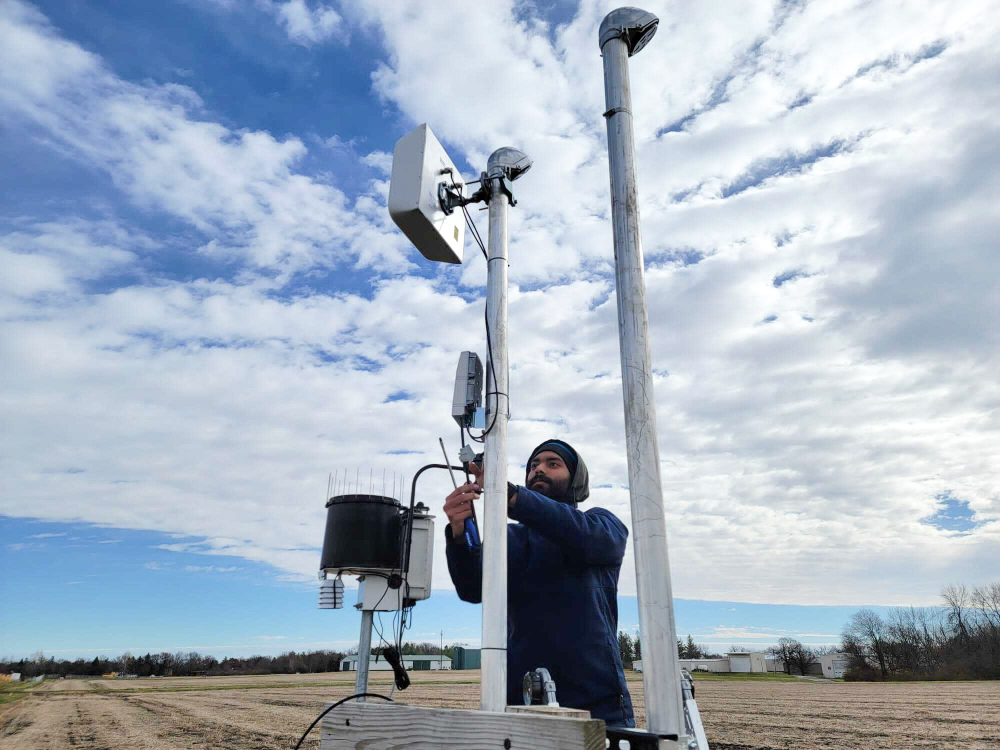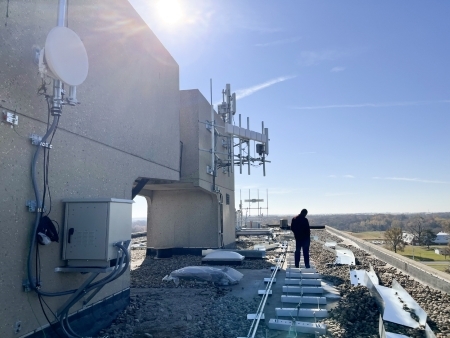
Doctoral student Md Nadim deploys hardware at an Iowa State research farm for the ARA rural broadband project. Larger photo. Photos courtesy of the ARA Project.
AMES, Iowa – A wireless tower at Iowa State University’s Ag Engineering/Agronomy Farm west of Ames is loaded with hardware sending radio waves across the countryside, creating wireless internet connections for rural users.
There are more poles, antennas and cabinets full of electronics on the roof of the Economic Development Core Facility at the Iowa State University Research Park. And bolted to the top of Wilson Hall, a 10-story residence hall. And hanging from the top of a wooden utility pole at Iowa State’s Curtiss Farm south of town.
There are also electronics and lower-to-the ground antennas next to research fields and in a sheep barn. There’s equipment going through the roof of a dairy barn. There are even hardware cabinets on the roof of a CyRide bus.
The deployment of all this infrastructure in and around Ames means the $16 million ARA Wireless Living Lab for Smart and Connected Rural Communities is moving to a public testing phase. The project’s progress will be celebrated during a launch event Sept. 6-8 on the Iowa State campus, including field trips to ARA deployment sites.
The event will feature technical presentations, including:
- “ARA-Enabled Teleoperation of Automated PhenoBots,” by Lie Tang, an Iowa State professor of agricultural and biosystems engineering and a Plant Sciences Institute faculty scholar
- “ARA-Enabled Livestock Health Monitoring” by Joshua Peschel, an Iowa State associate professor of agricultural and biosystems engineering
- and, “ARA-Enabled Agriculture Automation” by Matthew Darr, the John Deere Endowed Chair in Agricultural Innovation and leader of Iowa State’s Digital Ag Innovation Lab.
Details and a program are here.
A major goal for the ARA project is to address the broadband gap between rural and urban regions and to advance the frontiers of 5G and 6G technologies, said Hongwei Zhang, an Iowa State professor of electrical and computer engineering and the project leader.
Toward a ‘Broadband Prairie’
The ARA project launched in June 2021, when the Platforms for Advanced Wireless Research (PAWR) program, which is supported by the National Science Foundation (NSF) and a consortium of 30 wireless companies and associations, announced $16 million in support for ARA (which stands for Agriculture and Rural Communities and has a logo featuring the Ara constellation of stars).
Over five years, the NSF is providing $7 million, the U.S. Department of Agriculture’s National Institute of Food and Agriculture is providing $1 million and PAWR industry partners are providing $8 million of cash and in-kind support.
In addition to Zhang, there are major contributors from Iowa State faculty, staff and students. The project is part of Iowa State’s Center for Wireless, Communities and Innovation.
Other project leaders are affiliated with the University of California, Irvine, Ohio State University and the International Computer Science Institute at the University of California, Berkeley.
“This two-year effort is coming to fruition,” Zhang said. “ARA phase one has been deployed for research, education and innovation in advanced wireless and its rural applications.”
While a project goal is to eventually improve wireless service to rural residents and communities, project researchers are now building a wireless platform using the latest technology and testing its performance in variety of applications, including precision agriculture and rural education.
As a wireless testbed, researchers write and talk of ARA’s technical details: AraHaul for multi-modal, long-distance and high-throughput wireless; AraRAN wireless access infrastructure for connecting to equipment such as tractors; many-antenna, multiple-input and multiple-output systems, x-haul radios operating in the 11 gigahertz and 80 gigahertz bands; the TV White Space spectrum and Open Radio Access Networks (O-RAN).
Successfully tie all that together and Zhang envisions ARA one day enabling a “Broadband Prairie” that connects rural residents, farms, schools and communities.
“We are on track,” Zhang said. “We are overcoming challenges. And I can’t wait for this to go public.”








